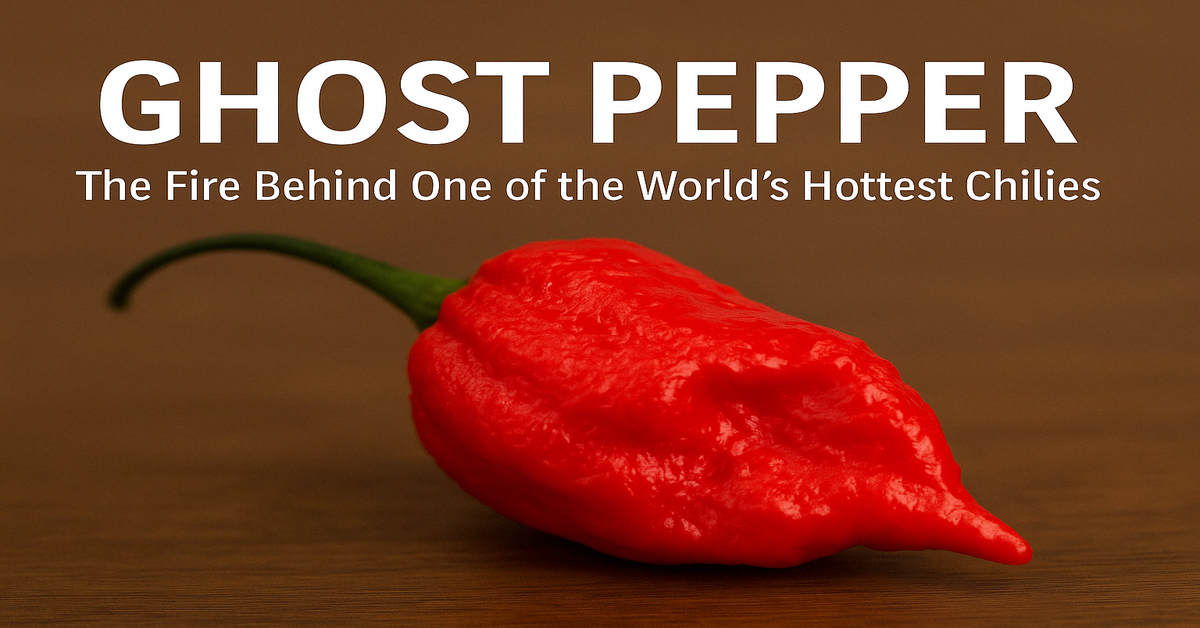Among the many peppers that populate the global spice landscape, none command as much awe—or fear—as the ghost pepper. Known for its blistering heat and distinct flavor profile, the ghost pepper has built a reputation that straddles culinary adventure and cautionary tale.
Originating from Northeast India, the ghost pepper is not just a chili; it’s a phenomenon. It has sparked global culinary challenges, inspired hot sauce enthusiasts, and fascinated scientists with its capsaicin levels. But beyond its heat lies a plant steeped in agricultural tradition, regional identity, and even medical interest.
This comprehensive guide explores every facet of the ghost pepper’s—from its origins and biology to its culinary uses, safety considerations, and myths.
The Origins of the Ghost Pepper
A Chili Rooted in Indian Soil
The ghost pepper’s, known natively as Bhut Jolokia, originates from the Assam, Nagaland, and Manipur regions of India. The word Bhut means “ghost” in Assamese, which refers either to its stealthy heat or its powerful punch.
It was traditionally used in:
- Spicy curries
- Chutneys
- Folk medicine
- Elephant deterrents (believe it or not!)
A Record-Setting Chili
In 2007, the ghost pepper earned global fame when it was declared the world’s hottest chili by Guinness World Records, measuring over 1,000,000 Scoville Heat Units (SHU). Though later surpassed by even hotter chilies, the ghost pepper’s retains a legendary status among spice enthusiasts.
Understanding the Heat: The Scoville Scale
What Is the Scoville Heat Unit?
The Scoville scale is used to measure the spiciness or heat of chili peppers, based on capsaicin concentration—the compound responsible for producing that familiar burn.
- Bell Pepper: 0 SHU
- Jalapeño: 2,500–8,000 SHU
- Habanero: 100,000–350,000 SHU
- Ghost Pepper: 800,000–1,041,427 SHU
Why Is It So Hot?
The ghost pepper’s contains an unusually high concentration of capsaicinoids, especially capsaicin and dihydrocapsaicin. Its heat builds slowly, peaking after about 30–45 seconds, which surprises many first-timers expecting an instant punch.
Plant Characteristics and Growth Habits
Appearance and Morphology
The ghost pepper plant is relatively tall and bushy. Its pods are:
- 2.5 to 3.5 inches long
- Wrinkled, bumpy texture
- Pointed tip
- Color range: Green (unripe) to red, orange, chocolate, or even white when ripe
Growing Conditions
Ghost peppers need:
- Warm climates (ideally 75–95°F)
- Full sun exposure
- Well-drained soil with organic matter
They are slow-growing and may take 120 days or more from transplant to harvest.
Harvesting and Yield
- Typically yields 15–40 peppers per plant
- Harvest when the pods have fully ripened to red or desired color variant
- Handle with gloves to avoid capsaicin burns
Culinary Uses and Applications
Cooking with Caution
Due to its intense heat, ghost pepper’s is used sparingly in food. It’s often found in:
- Hot sauces
- Salsas and chutneys
- Marinades and dry rubs
- Spicy condiments
One small piece can flavor an entire dish—or ruin it if not handled correctly.
Recipes Featuring Ghost Pepper
- Ghost Pepper Chili – Adds smoky fire to slow-cooked chili recipes.
- Ghost Pepper Hot Sauce – Mixed with vinegar, garlic, and fruit for a balance of flavor and heat.
- Spicy BBQ Rubs – Powdered ghost pepper adds kick to grilled meats.
- Pickled Ghost Peppers – Infused with garlic and spices for daring pickle lovers.
Ghost Pepper in Processed Products
- Ghost pepper chips
- Chili chocolates
- Ghost-infused oil or honey
- Extreme hot sauces
These products are marketed toward heat lovers and often come with disclaimers.
Health Benefits and Risks
Health Benefits
Ghost peppers offer several potential benefits due to their capsaicin content:
- Metabolism boost
- Pain relief
- Anti-inflammatory properties
- Antioxidants for immune support
- Appetite suppression
Some studies even explore its role in cancer research, as capsaicin may target certain cancer cells.
Risks and Precautions
Despite the benefits, overconsumption can lead to:
- Gastrointestinal discomfort
- Burning sensations
- Sweating and dizziness
- Short-term nausea
Ghost peppers are not recommended for those with:
- Peptic ulcers
- Acid reflux
- Capsaicin sensitivity
Always use gloves when cutting or handling ghost peppers. Keep them away from your eyes, nose, and open wounds.
The Ghost Pepper in Pop Culture
Internet Challenges
Ghost peppers rose to pop fame through viral videos of people attempting to eat them raw. These “challenges” are entertaining but often painful and should never be tried without caution.
Popular formats include:
- “One Chip Challenge” with ghost pepper seasoning
- Ghost pepper burger challenges at restaurants
- Hot sauce tasting competitions
Culinary TV and Media
From shows like Hot Ones to cooking competitions, ghost peppers are often featured as the pinnacle of spicy ingredients, challenging even the most seasoned chefs.
Growing Ghost Peppers at Home
Starting from Seed
Ghost pepper seeds:
- Require warm, consistent soil temperatures (80–90°F) to germinate
- Take 2–4 weeks to sprout
- Prefer to be started indoors and transplanted after danger of frost
Best Practices
- Use peat pots or seed trays
- Maintain high humidity
- Transplant to 5-gallon containers or directly into garden beds
Common Growing Problems
- Slow growth due to cold soil or inadequate light
- Leaf curling from overwatering
- Flower drop due to excess nitrogen
Ghost Pepper Varieties
Red Ghost Pepper
The classic Bhut Jolokia—most common and widely recognized.
Chocolate Ghost Pepper
Dark brown and slightly smokier in flavor.
Peach Ghost Pepper
Pale, peach-colored with a fruitier tone but still blisteringly hot.
Yellow Ghost Pepper
Vibrant and citrusy, often used for colorful hot sauces.
Each variety maintains the signature ghost heat but differs slightly in flavor and appearance.
Agricultural and Economic Importance
Farming in India and Abroad
In India, ghost pepper farming is part of traditional agriculture, particularly in small-scale operations in the Northeast. Today, it is also grown in:
- The United States (Southern states and greenhouses)
- Southeast Asia
- Africa (as a novelty crop)
Commercial Appeal
Ghost peppers are in demand globally for:
- Gourmet foods
- Specialty sauces
- Medicinal research
- Agricultural products (e.g., pest deterrents)
Because of their high value per unit, even small yields can be profitable.
Myths and Folklore
Myth: Ghost Peppers Can Kill You
While eating ghost peppers can cause extreme discomfort, fatalities are extraordinarily rare. However, complications can arise from choking or underlying health conditions.
Myth: Drinking Water Helps
False. Water spreads capsaicin. Instead, reach for:
- Milk
- Yogurt
- Bread or starchy foods
- Acidic liquids (like lime juice)
Myth: Ghost Peppers Are the Hottest
As of now, several peppers surpass ghost pepper in heat (e.g., Carolina Reaper, Trinidad Scorpion), but ghost pepper remains iconic due to its balanced mix of heat and flavor.
Safety Guidelines and Best Practices
Handling Safely
Always:
- Wear gloves
- Use separate cutting boards
- Wash hands thoroughly
- Keep away from children and pets
Cooking Tips
- Use sparingly—start with a tiny sliver
- Blend with sweet or acidic ingredients to balance the heat
- Store leftovers in clearly labeled containers
Conclusion
The ghost pepper is more than a scorching chili—it’s a cultural icon, an agricultural asset, and a culinary weapon of choice for heat lovers. From its roots in India’s mountainous terrain to global kitchens and food challenges, the ghost pepper has carved a path unlike any other chili.
Balancing fire with flavor, tradition with innovation, the ghost pepper commands respect. While it should be handled carefully and consumed thoughtfully, there’s no denying its impact on cuisine, agriculture, and pop culture alike.
For thrill-seekers and flavor explorers alike, the ghost pepper is both a test and a treat—one that continues to captivate and ignite culinary curiosity around the world.
FAQs
1. How hot is a ghost pepper?
Ghost peppers measure between 800,000 to over 1,000,000 Scoville Heat Units (SHU), making them one of the hottest peppers in the world.
2. Can I grow ghost peppers at home?
Yes. Ghost peppers can be grown from seed with proper warmth, light, and care. They prefer tropical or warm environments and take about 120 days to mature.
3. Are ghost peppers safe to eat?
Yes, but they should be eaten in very small amounts and with caution. People with digestive issues should consult a doctor before trying them.
4. What do ghost peppers taste like?
Aside from their intense heat, ghost peppers offer a fruity, slightly smoky flavor, especially when cooked or made into sauces.
5. Can ghost peppers be used in medicine?
Capsaicin, the active compound in ghost peppers, is studied for pain relief, metabolism support, and even cancer research. However, it’s used in controlled, purified doses.
6. How do I stop the burning after eating a ghost pepper?
Consume milk, yogurt, bread, or acidic juices like lime. Avoid water, which only spreads the capsaicin and intensifies the burn.











